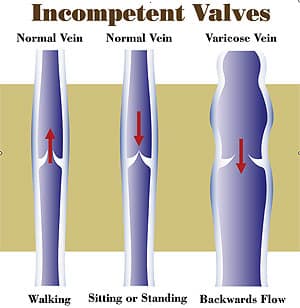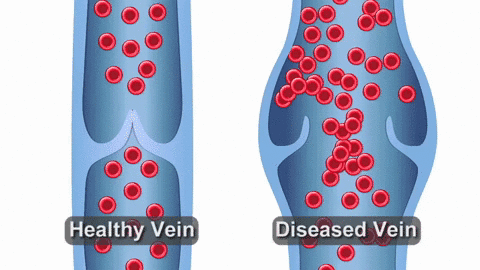Veins are the vessels that return blood to the heart once it has circulated through the body (as opposed to arteries, which carry oxygen-rich blood from the heart to the body). Veins have one-way valves that propel blood in the proper direction. If these one way valves stop functioning properly, blood can flow backwards, called venous insufficiency. The backwards flow of blood causes “pooling” in the vein, causing it to stretch. This process of venous insufficiency leading to pooling and stretching results in varicose veins.


Varicose veins are swollen, dark blue or purple blood vessels that you can usually see and feel beneath the skin. They often look like twisted ropes, and usually appear on the thighs, calves, and ankles. Some patients with varicose veins are free from symptoms. Most however develop aching, throbbing, cramping and or pain that may indicate the need for medical attention. Sometimes, however, more significant problems including bleeding, ulcers, blood clots, pulmonary embolus, and or death can develop if abnormal veins are left untreated.
There are several treatment options available to eliminate or reduce the varicose veins and relieve symptoms. Conservative measures are recommended first and these include self-care methods such as losing weight, keeping the legs elevated, and wearing compression stockings.
For veins that do not respond to these remedies, more advanced treatments such as Ultrasound Guided Foam Sclerotherapy, microphlebectomy, or Endovenous laser ablation therapy may be required.

Contact our New Orleans Office:
One Galleria Boulevard
Suite 100
Metairie, Louisiana, 70001
Hours:
Mon – Thurs, 7:30AM – 5:00PM
Friday, 7:30AM – 12:00PM
Closed Daily for Lunch 12:00PM – 1:00PM
Contact our Baton Rouge Office:
10101 Siegen Ln
#3B
Baton Rouge, Louisiana 70810
Hours:
Mon – Thurs, 7:30AM – 5:00PM
Friday, 7:30AM – 12:00PM
Closed Daily for Lunch 12:00PM – 1:00PM

Gitter Vein Institute invites you to experience a new type of medical environment. We commit our focus and expertise to earn your confidence and trust.